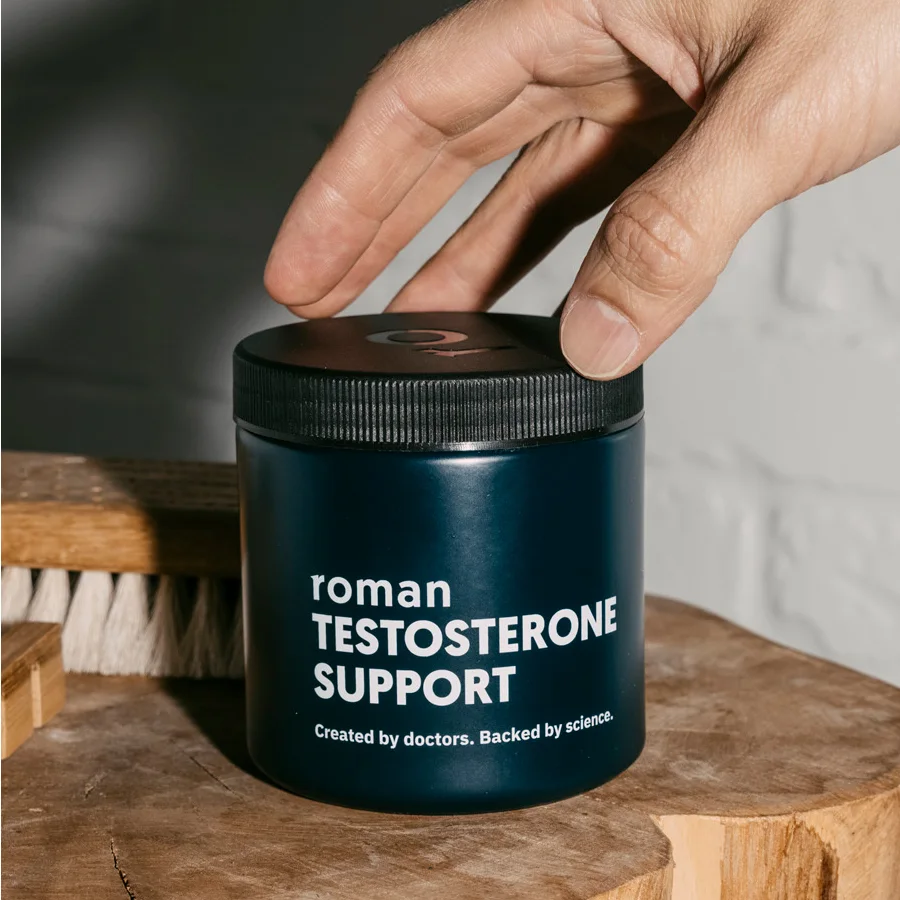Here's what we'll cover
Here's what we'll cover
Here's what we'll cover
If you’re reading this, you’ve probably been thinking about your testosterone (T) levels. Maybe you’ve talked to a friend who said he’s optimizing his T with the help of injections or medications, or perhaps you’ve overheard a conversation at the gym or read a Reddit thread about anabolic steroid cycles.
Or maybe testosterone is more than just a curiosity for you—you’ve noticed a “slowdown” in yourself, including fatigue, low sex drive, and muscle loss, and think it might stem from declining testosterone levels. That wouldn’t be uncommon, after all. As men age, T levels naturally decline. According to some studies, testosterone levels decline about 1% to 2% a year, starting around age 40, and an estimated 39% of men 45 or older have low testosterone, defined as a blood concentration of less than 300 ng/dL (Miah, 2019; Mulligan, 2006).
Treating low testosterone: you have options
If you’re researching treatments for low T online, chances are the first thing you come across is testosterone replacement therapy, also known as TRT. TRT means restoring your testosterone to normal, healthy levels by replacing your body’s missing testosterone with pharmaceutically manufactured T. TRT is available through injections or gels prescribed by your healthcare provider. While TRT is often touted as a cure-all for the broadest of symptoms, the reality is it can come with myriad side effects. And more importantly, TRT is not the only option to treat low T.
You might have also read about a prescription drug called Clomid (generic name: clomiphene or clomiphene citrate)—an alternative to testosterone replacement therapy without many of the side effects. Healthcare providers can prescribe Clomid off-label for hypogonadism in men, a condition that involves low levels of sperm, testosterone, or both.
Before we dive into the differences between Clomid and TRT, please keep in mind that, whether you think you have symptoms of low testosterone or just want to know your levels, it’s important to be evaluated by a healthcare provider instead of jumping straight to treatment. If you have normal T levels, boosting your testosterone to even higher levels (like what is done with anabolic steroids) for more “gains” at the gym can come with potentially serious and life-threatening side effects.
To diagnose low T, your provider will usually test your levels early in the morning (when testosterone levels are highest) on two separate mornings. Two low readings (<300 ng/dL), along with clinical symptoms, are usually required for a diagnosis. You don’t have to go to a healthcare provider’s office for that—there are safe and easy home tests, or “testosterone kits” available that can measure testosterone levels and other hormones with just a few drops of blood.
Clomid vs. TRT: what’s the difference?
The key difference between Clomid and TRT for low T is how the two medications raise testosterone levels.
As we learned earlier, TRT often comes in the form of injections that replace the missing testosterone with pharmaceutically manufactured testosterone. Clomid, a pill taken daily or every other day, uses a different approach to increase testosterone, as it stimulates the body’s own production of testosterone.
Here’s what that means: If you have low T, think of your testicles—which are where testosterone is made—as a factory that isn’t able to produce enough testosterone. TRT means you’re skipping your own factory altogether and supplying the product (testosterone) from an outside source. The problem here is that since you’re getting the product from somewhere else, you don’t really need your own factory (testicles) anymore, so it becomes idle and shuts down. With Clomid, however, your factory doesn’t rely on outside products. Clomid relies on your own factory and tricks your brain into making your testicles increase testosterone output.
Since TRT can shut down your own testosterone factory (testicles), it comes with a range of side effects. One of them is infertility. Simply put, if the brain notices a high testosterone level because of TRT, it stops telling the testes to produce testosterone and sperm, potentially harming male fertility. Clomiphene, on the other hand, can maintain male fertility while gradually increasing testosterone levels (Wheeler, 2019). That’s why men with low T who want to start a family may opt for clomiphene over TRT.
Clomid vs. TRT: which is better?
If you’re diagnosed with low T and your healthcare provider recommends treatment, you might wonder what approach is right for you. Should I start injecting testosterone, or shall I ask my healthcare provider about alternatives, like clomiphene? Ultimately, you and your healthcare provider will make that decision together, depending on your medical history and preferences.
But one important question you should ask yourself is whether you want to have children anytime soon. As we said earlier, traditional testosterone replacement therapy has the downside of potentially “turning off” the body’s own testosterone and sperm production, which can result in fertility issues (Patel, 2019). So, if you want to be a dad and preserve fertility, ask your healthcare provider if TRT is right for you or if they recommend an alternative, such as Clomid.
Another thing to keep in mind is the side effects. Some men may prefer Clomid to testosterone replacement therapy because of its comparably mild side effects. Clomid is typically well-tolerated. Severe side effects are rare, and long-term studies have confirmed the overall safety of Clomid. Common side effects of Clomid in men can include headaches, mood changes, blurry vision, and in some cases, sore breast tissue (Krzastek, 2019).
However, clomiphene can take longer to affect symptoms of low T. Since clomiphene raises your T gradually by using the body’s own testosterone factory, it may take a bit longer to see T levels rise, especially if you have very low T levels. Some studies suggest that clomiphene can bring T levels back to a normal range after about 1–2 months of treatment, and improvements in low T symptoms might take even longer (Shabsigh, 2005). Studies on TRT in men suffering from low T symptoms, such as lack of libido and depression, found that positive effects can be seen after as little as 3–6 weeks (Walther, 2019; Saad, 2011).
If you suspect you have low T or are concerned about your T levels, talk to a healthcare provider or take a testosterone test to see if your levels are normal. Depending on your results, your healthcare provider will help you develop a safe treatment plan that’s right for you.
DISCLAIMER
If you have any medical questions or concerns, please talk to your healthcare provider. The articles on Health Guide are underpinned by peer-reviewed research and information drawn from medical societies and governmental agencies. However, they are not a substitute for professional medical advice, diagnosis, or treatment.
References
Krzastek, S. C., Sharma, D., Abdullah, N., et al. (2019). Long-term safety and efficacy of Clomiphene Citrate for the treatment of hypogonadism. Journal of Urology, 202 (5), 1029-1035. doi: 10.1097/JU.0000000000000396. Retrieved from https://pubmed.ncbi.nlm.nih.gov/31216250/
Miah, S., Tharakan, T., Gallagher, K. A., et al. (2019). The effects of testosterone replacement therapy on the prostate: a clinical perspective. F1000Research, 8 , F1000 Faculty Rev-217. doi:10.12688/f1000research.16497.1. Retrieved from https://www.ncbi.nlm.nih.gov/pmc/articles/PMC6392157/
Mulligan, T., Frick, M. F., Zuraw, Q. C., et al. (2006). Prevalence of hypogonadism in males aged at least 45 years: the HIM study. International Journal of Clinical Practice, 60 (7), 762–769. doi:10.1111/j.1742-1241.2006.00992. Retrieved from https://pubmed.ncbi.nlm.nih.gov/16846397/
Patel, A. S., Leong, J. Y., Ramos, L., & Ramasamy, R. (2019). Testosterone is a contraceptive and should not be used in men who desire fertility. The World Journal of Men’s Health , 37 (1), 45–54. doi:10.5534/wjmh.180036. Retrieved from https://www.ncbi.nlm.nih.gov/pmc/articles/PMC6305868/
Saad, F., Aversa, A., Isidori, A. M., et al. (2011) Onset of effects of testosterone treatment and time span until maximum effects are achieved. European Journal of Endocrinology, 165 (5), 675-685. doi:10.1530/EJE-11-0221. Retrieved from https://www.ncbi.nlm.nih.gov/pmc/articles/PMC3188848/
Shabsigh, A. Kang, Y.,Shabsign, R., et al. (2005) Clomiphene citrate effects on testosterone/estrogen ratio in male hypogonadism. Journal of Sexual Medicine, 2 (5), 716–721. doi:10.1111/j.1743-6109.2005.00075. Retrieved from https://pubmed.ncbi.nlm.nih.gov/16422830/
Walther, A., Breidenstein, J., & Miller, R. (2019) Association of testosterone treatment with alleviation of depressive symptoms in men: A systematic review and meta-analysis. JAMA Psychiatry, 76 (1), 31–40. doi:10.1001/jamapsychiatry.2018.2734. Retrieved from https://pubmed.ncbi.nlm.nih.gov/30427999/
Wheeler, K. M., Sharma, D., Kavoussi, P. K., et al. (2019). Clomiphene citrate for the treatment of hypogonadism. Sexual Medicine Reviews, 7(2), 272–276. doi: 10.1016/j.sxmr.2018.10.001. Retrieved from https://pubmed.ncbi.nlm.nih.gov/30522888/












